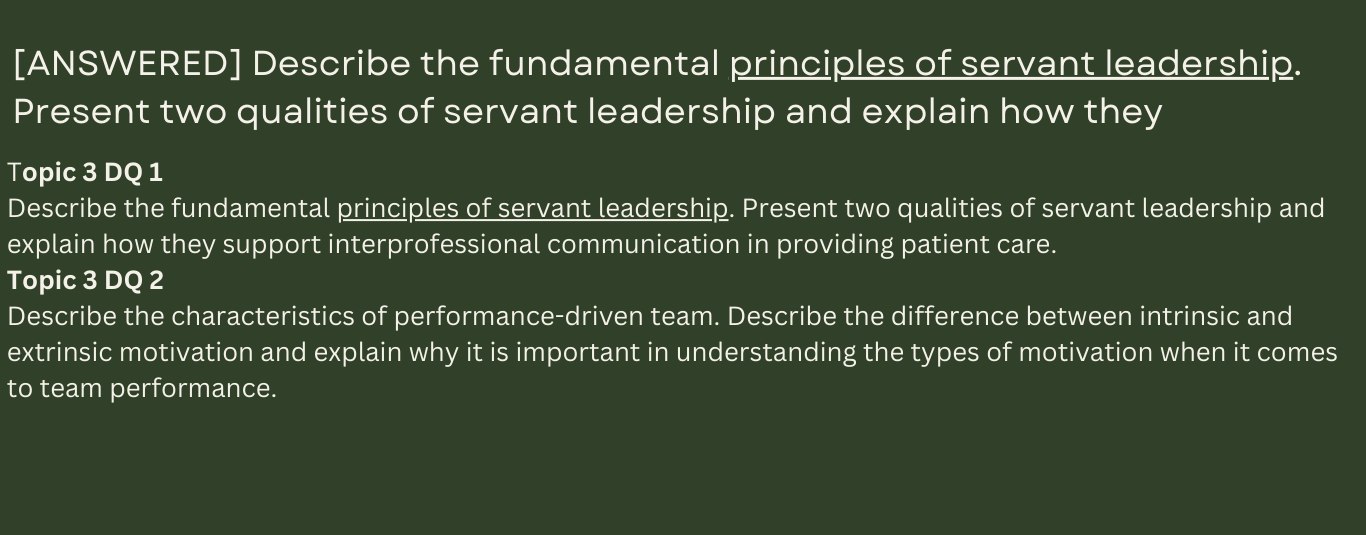Describe the fundamental principles of servant leadership. Present two qualities of servant

Topic 3 DQ 1
Describe the fundamental principles of servant leadership. Present two qualities of servant leadership and explain how they support interprofessional communication in providing patient care.
Expert Answer and Explanation
Servant Leadership
Fundamental principles of Servant leadership
Servant leadership is the concept of leading by example other than providing instructions and leaving the employees to figure out on their own. The first principle of servant leadership is persuasion where the leader can advocate for collaboration and working with one another to achieve common goal (Gunnarsdóttir et al., 2018).
The second principle is listening where the leader interacts with the members and acquires different opinions from each member and identify the best cause of action. The third principle is commitment to growth of their employees to achieve organizational value. A servant leader invests in their employees through trainings and seminars to ensure continued growth. The leader is able to help the employees find their purpose and stay motivated with their individual responsibilities.
Qualities of a Servant Leader
The first quality of a servant leader is self-awareness where one can understand their strengths and weaknesses. In nursing, interprofessional collaboration among nurses, physicians and other health care teams requires self-awareness from the leaders (Eva et al., 2019). This will help in terms of effective communication from the leadership to the employees having understood oneself. Self-awareness contributes to patient care in that nurse and physicians are able to perform their roles effectively to the patients because of the team’s collaboration and proper communication.
With good leadership, health workers are able to embrace their roles, work cooperatively and make decisions to carry out patient care. The second quality is empathy where the servant leaders understand their employees and do not disregard their point of views (Aij & Rapsaniotis, 2017). When health workers recognize that their leaders care about them and understands them, then trust is built among the team. A result of this is that health workers are motivated to perform their tasks more effectively.
References
Aij, K. H., & Rapsaniotis, S. (2017). Leadership requirements for Lean versus servant leadership in health care: a systematic review of the literature. Journal of Healthcare Leadership, 9, 1. DOI: 10.2147/JHL.S120166
Eva, N., Robin, M., Sendjaya, S., van Dierendonck, D., & Liden, R. C. (2019). Servant leadership: A systematic review and call for future research. The leadership quarterly, 30(1), 111-132. https://doi.org/10.1016/j.leaqua.2018.07.004
Gunnarsdóttir, S., Edwards, K., & Dellve, L. (2018). Improving health care organizations through servant leadership. In Practicing Servant Leadership (pp. 249-273). Palgrave Macmillan, Cham. https://doi.org/10.1007/978-3-319-75644-8_14
Topic 3 DQ 2
Describe the characteristics of performance-driven team. Describe the difference between intrinsic and extrinsic motivation and explain why it is important in understanding the types of motivation when it comes to team performance.
Performance Driven Team
Teams are important in the attainment of organizational goals and also the fulfillment of individual career objectives. Through teams, members can identify clear road paths and how to best meet the company’s needs and demands. In this regard, performance-driven teams are important in ensuring that assigned tasks are completed within the needed time and that all the key issues associated with governance and conflict resolutions are dealt with internally (Tortorella et al., 2021).
To be considered as a performance-driven team, there are various characteristics that have to be met. For instance, there is a need for setting clear goals both for the team and individual objectives within the team. There is also the need to have clearly defined responsibilities and roles for each member and how they relate with one another.
Proper communication and engagement among the team member need to also be put in place to ensure proper collaborations and outcomes (SHRM, n.d.). The team leader should also demonstrate empathy, self-awareness, and good governance to manage the different members as a team while also accepting diversity and differences in opinions.
Other than a performance-driven team, there is also the need for intrinsic and extrinsic motivation within each member. Intrinsic motivation is the personal attributes that improve the willingness of a person to engage in the activity while extrinsic motivation focuses on the benefit that they are getting such as salary increment of promotions (Kuvaas et al., 2017).
Understanding the different type of motivation help in determining the issues affecting the group members and providing the necessary input to increase the motivation or resolve conflicts. The information on motivation can also help improve the overall performance of the team as each induvial person will be motivated to meet the objectives.
References
Kuvaas, B., Buch, R., Weibel, A., Dysvik, A., & Nerstad, C. G. (2017). Do intrinsic and extrinsic motivation relate differently to employee outcomes?. Journal of Economic Psychology, 61, 244-258.
SHRM. (n.d.). Developing and Sustaining High-Performance Work Teams. Society for Human Resource Management. https://www.shrm.org/resourcesandtools/tools-and-samples/toolkits/pages/developingandsustaininghigh-performanceworkteams.aspx
Tortorella, G. L., Fogliatto, F. S., Mac Cawley Vergara, A., Luis Gonçalves Quelhas, O., & Sawhney, R. (2021). Influence of team members’ characteristics on the sustainability of continuous improvement initiatives. Total Quality Management & Business Excellence, 32(7-8), 852-868.
Place your order now for a similar assignment and get fast, cheap and best quality work written by our expert level assignment writers. Use Coupon Code: NEW30 to Get 30% OFF Your First Order
Use Coupon Code: NEW30 to Get 30% OFF Your First Order
FAQs
- 10 principles of servant leadership
- Importance of servant leadership
- 7 principles of servant leadership
- Servant leadership in nursing examples
- Fundamental principles of servant leadership in nursing
- Examples of servant leadership in healthcare
- What are the 5 principles of servant leadership


